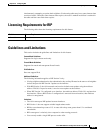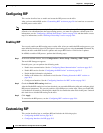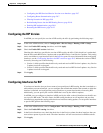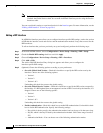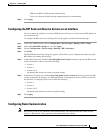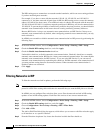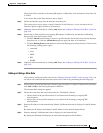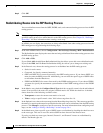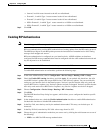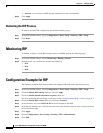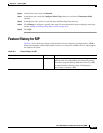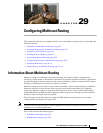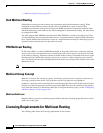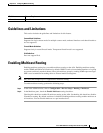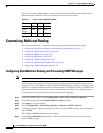
28-11
Cisco ASA 5500 Series Configuration Guide using ASDM
Chapter 28 Configuring RIP
Customizing RIP
• Internal, in which routes internal to the AS are redistributed.
• External 1, in which Type 1 routes external to the AS are redistributed.
• External 2, in which Type 2 routes external to the AS are redistributed.
• NSSA External 1, in which Type 1 routes external to an NSSA are redistributed.
• NSSA External 2, in which Type 2 routes external to an NSSA are redistributed.
Step 7 Click OK.
Enabling RIP Authentication
Note The ASA supports RIP message authentication for RIP Version 2 messages.
RIP route authentication provides MD5 authentication of routing updates from the RIP routing protocol.
The MD5 keyed digest in each RIP packet prevents the introduction of unauthorized or false routing
messages from unapproved sources.
RIP route authentication is configured on a per-interface basis. All RIP neighbors on interfaces
configured for RIP message authentication must be configured with the same authentication mode and
key for adjacencies to be established.
Note Before you can enable RIP route authentication, you must enable RIP.
To enable RIP authentication on an interface, perform the following steps:
Step 1 In the main ASDM window, choose Configuration > Device Setup > Routing > RIP > Setup.
Step 2 Check the Enable RIP routing check box, and click Apply. If you uncheck this check box, the ASA
sends RIP Version 1 updates and accepts RIP Version 1 and Version 2 updates. You can override this
setting on a per-interface basis in the Interface pane. Version 1 specifies that the ASA only sends and
receives RIP Version 1 updates. Any Version 2 updates received are dropped. Version 2 specifies that the
ASA only sends and receives RIP Version 2 updates. Any Version 1 updates received are dropped.
Step 3 Choose Configuration > Device Setup > Routing > RIP > Interface.
Step 4 Click Edit.
The Edit RIP Interface Entry dialog box appears, which allows you to configure the interface-specific
RIP settings.
Step 5 In the Authentication area, check the Enable Authentication check box to enable RIP authentication.
Uncheck this check box to disable RIP authentication.
Step 6 In the Key field, enter the key used by the authentication method. This entry can include up to 16
characters.
Step 7 In the Key ID field, enter the key ID. Valid values range from 0 to 255.
Step 8 Choose the type of authentication mode that you want to use by clicking the radio button next to one of
the following:
• MD5 to use MD5 for RIP message authentication.



